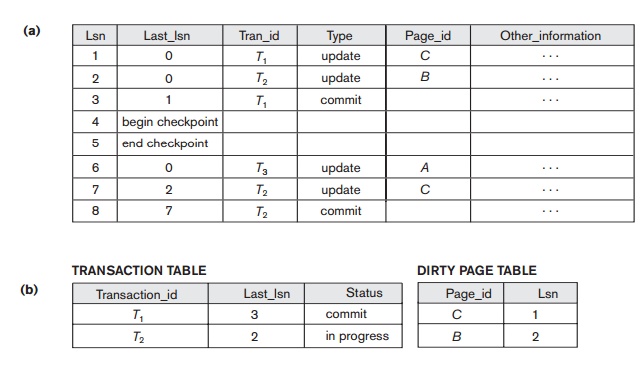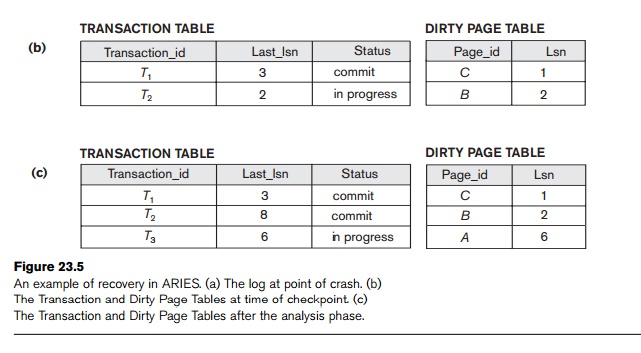Chapter: Fundamentals of Database Systems : Transaction Processing, Concurrency Control, and Recovery : Database Recovery Techniques
The ARIES Recovery Algorithm
The ARIES Recovery Algorithm
We now
describe the ARIES algorithm as an example of a recovery algorithm used in
database systems. It is used in many relational database-related products of
IBM. ARIES uses a steal/no-force approach for writing, and it is based on three
concepts: write-ahead logging, repeating history during redo, and logging
changes during undo. We discussed write-ahead logging in Section 23.1.3. The
second concept, repeating history,
means that ARIES will retrace all actions of the database system prior to the crash to reconstruct the
database state when the crash occurred.
Transactions that were uncommitted at the time of the crash (active
transactions) are undone. The third concept, logging during undo, will prevent ARIES from repeating the
completed undo operations if a failure occurs during recovery, which causes a
restart of the recovery process.
The ARIES
recovery procedure consists of three main steps: analysis, REDO, and UNDO. The analysis
step identifies the dirty (updated)
pages in the buffer and the set of transactions active at the
time of the crash. The appropriate point in the log where the REDO operation should start is also
determined. The REDO phase actually reapplies updates from
the log to the database. Generally, the REDO
operation is applied only to committed transactions. However, this is not the
case in ARIES. Certain information in the ARIES log will provide the start
point for REDO, from
which REDO operations are applied until the
end of the log is reached. Additionally, information stored by ARIES and in the
data pages will allow ARIES to determine whether the operation to be redone has
actually been applied to the database and therefore does not need to be
reapplied. Thus, only the necessary REDO
operations are applied during recovery. Finally, during the UNDO phase, the log is scanned backward and the operations of
transactions that were active at the time of the crash are undone in reverse
order. The information needed for ARIES to accomplish its recovery procedure
includes the log, the Transaction Table, and the Dirty Page Table.
Additionally, checkpointing is used. These tables are maintained by the
trans-action manager and written to the log during checkpointing.
In ARIES,
every log record has an associated log
sequence number (LSN) that is monotonically increasing and indicates the
address of the log record on disk. Each LSN corresponds to a specific change (action) of some
transaction. Also, each data page will store the LSN of the latest log record corresponding to a change
for that page.
A log
record is written for any of the following actions: updating a page (write),
committing a transaction (commit), aborting a transaction (abort), undoing an
update (undo), and ending a transaction (end). The need for including the first
three actions in the log has been discussed, but the last two need some
explanation. When an update is undone, a compensation
log record is written in the log. When a transaction ends, whether by
committing or aborting, an end log record
is written.
Common
fields in all log records include the previous LSN for that transaction, the
transaction ID, and the type of log record. The previous LSN is important
because it links the log records (in reverse order) for each transaction. For
an update (write) action, additional fields in the log record include the page
ID for the page that contains the item, the length of the updated item, its
offset from the beginning of the page, the before image of the item, and its
after image.
Besides
the log, two tables are needed for efficient recovery: the Transaction Table and the Dirty
Page Table, which are maintained by the transaction manager. When a crash
occurs, these tables are rebuilt in the analysis phase of recovery. The
Transaction Table contains an entry for each
active transaction, with information such as the transaction ID,
transaction status, and the LSN of the most recent log record for the
transaction. The Dirty Page Table contains an entry for each dirty page in the
buffer, which includes the page ID and the LSN corresponding to the earliest
update to that page.
Checkpointing in ARIES consists of the
following: writing a begin_checkpoint record to the log, writing an end_checkpoint record to the log, and writing the LSN
of the begin_checkpoint record to a special file. This special file is
accessed during recovery to locate
the last checkpoint information. With the end_checkpoint record,
the con-tents of both the Transaction Table and Dirty Page Table are appended
to the end of the log. To reduce the cost, fuzzy
checkpointing is used so that the DBMS can continue to execute
transactions during checkpointing (see Section 23.1.4). Additionally, the
contents of the DBMS cache do not have to be flushed to disk during
checkpoint, since the Transaction Table and Dirty Page Table—which are appended
to the log on disk—contain the information needed for recovery. Note that if a
crash occurs during checkpointing, the special file will refer to the previous
checkpoint, which is used for recovery.
After a
crash, the ARIES recovery manager takes over. Information from the last
checkpoint is first accessed through the special file. The analysis phase starts at the begin_checkpoint
record
and proceeds to the end of the log. When the
end_checkpoint record is encountered, the Transaction Table and
Dirty Page Table are accessed (recall that these tables were written in the log
during checkpointing). During analysis, the log records being analyzed may
cause modifications to these two tables. For instance, if an end log record was
encountered for a transaction T in
the Transaction Table, then the entry for T
is deleted from that table. If some other type of log record is encountered for
a transaction T , then an entry for T is inserted into the Transaction
Table, if not already present, and the last LSN field is modified. If the log
record corresponds to a change for page P,
then an entry would be made for page P
(if not present in the table) and the associated LSN field would be modified.
When the analysis phase is complete, the necessary information for REDO and UNDO has been compiled in the tables.
The REDO phase follows next. To reduce the amount of unnecessary work, ARIES
starts redoing at a point in the log where it knows (for sure) that previous
changes to dirty pages have already been
applied to the database on disk. It can determine this by finding the
smallest LSN, M, of all the dirty
pages in the Dirty Page Table, which indicates the log position where ARIES
needs to start the REDO phase.
Any changes corresponding to an LSN < M,
for redoable transactions, must have already been propagated to disk or already
been overwritten in the buffer; otherwise, those dirty pages with that LSN
would be in the buffer (and the Dirty Page Table). So, REDO starts at the log record with
LSN = M and scans forward to the end
of the log. For each change recorded in the log, the REDO algorithm would verify whether
or not the change has to be reapplied. For example, if a change recorded in the
log pertains to page P that is not in
the Dirty Page Table, then this change is already on disk and does not need to
be reapplied. Or, if a change recorded in the log (with LSN = N, say) pertains to page P and the Dirty Page Table contains an
entry for P with LSN greater than N, then the change is already present.
If neither of these two conditions hold, page P is read from disk and the LSN stored on that page, LSN(P), is compared with N. If N < LSN(P), then the
change has been applied and the page does not need to be rewritten to disk.
Once the REDO phase is finished, the database
is in the exact state that it was in when the crash occurred. The set of active
transactions—called the undo_set—has been
identified in the Transaction Table during the analysis phase. Now, the UNDO phase proceeds by scanning backward from the end of the log and
undoing the appropriate actions. A
compensating log record is written for each action that is undone. The UNDO reads backward in the log until
every action of the set of trans-actions in the undo_set has been undone. When this is completed, the
recovery process is finished and normal processing can begin again.
Consider
the recovery example shown in Figure 23.5. There are three transactions: T1, T2, and T3. T1 updates page C, T2 updates pages B and C, and T3 updates
page A.


Figure 23.5(a)
shows the partial contents of the log, and Figure 23.5(b) shows the contents of
the Transaction Table and Dirty Page Table. Now, suppose that a crash occurs at
this point. Since a checkpoint has occurred, the address of the associated begin_checkpoint record is retrieved, which is
location 4. The analysis phase starts
from
location 4 until it reaches the end. The end_checkpoint record
would contain the Transaction Table and Dirty Page Table in Figure 23.5(b), and
the analysis phase will further reconstruct these tables. When the analysis
phase encounters log record 6, a new entry for transaction T3 is made in the Transaction Table and a new entry for
page A is made in the Dirty Page Table. After log record 8 is analyzed, the
status of transaction T2 is
changed to committed in the Transaction Table. Figure 23.5(c) shows the two
tables after the analysis phase.
For the REDO phase, the smallest LSN in the
Dirty Page Table is 1. Hence the REDO will
start at log record 1 and proceed with the REDO of
updates. The LSNs {1, 2, 6, 7} corresponding to the updates for pages C, B, A,
and C, respectively, are not less than the LSNs of those pages (as shown in the
Dirty Page Table). So those data pages will be read again and the updates
reapplied from the log (assuming the actual LSNs stored on those data pages are
less then the corresponding log entry). At this point, the REDO phase is finished and the UNDO phase starts. From the
Transaction Table (Figure 23.5(c)), UNDO is
applied only to the active transaction T3.
The UNDO phase starts at log entry 6 (the
last update for T3) and
proceeds backward in the log. The backward chain of updates for transaction T3 (only log record 6 in this
example) is followed and undone.
Related Topics